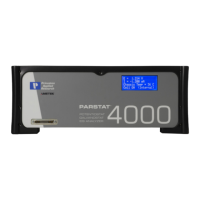PARSTAT 4000 Hardware Manual
PARSTAT 4000 Hardware Manual 12
2.2.1. Ventilation
PARSTAT 4000 specifications apply at the nominal line voltage + and at a temperature
of 25
o
C (77
o
F) unless otherwise noted. Ambient temperature must not exceed 50
o
C
(122
o
F). See Section 4.3 for more detailed environmental specifications.
To maintain a safe operating temperature, allow some free space (minimum 10 cm) at
either side and at the rear of the PARSTAT 4000 for adequate air circulation. There must
be adequate circulation between the spaces at the sides and rear of the instrument and
the ambient laboratory air. In a typical bench top installation, these requirements are
satisfied with a large safety margin.
CAUTION Because some of the ventilation for the PARSTAT 4000 is on the side
panels, rack mounting in an enclosed cabinet is not recommended.
The PARSTAT 4000 is equipped with onboard temperature sensors and ventilation fans
with variable speed control such that the fan speed will increase as the temperature
inside the system increases. Fan speeds will increase and can be audibly detected
when temperatures rise above 44
o
C inside the unit. Likewise, the control software
(VersaStudio) monitors the onboard temperature and fans, and will halt experiments
and disengage critical voltage inputs if either a critical thermal limit inside the unit is
detected (> 84
o
C) or any of the onboard ventilation fans stops working.
2.2.2. Radio Frequency Interference
In a typical application, it is unlikely that the PARSTAT 4000 will act as a source of
noticeable RF interference. However, when operated near particularly sensitive
equipment, interference from the PARSTAT 4000 could be a problem.
Below is a discussion of steps you can take to minimize that interference.
Interference below about 10 MHz is most likely to be caused by RF currents flowing in
the input and output cables or in the power line cord.
If excessive noise pickup is present, try decoupling the power line with an external filter.
At frequencies below 100 kHz, an external isolation transformer could be helpful.
WARNING: To reduce the risk of potentially dangerous electrical shock, only a
qualified service technician should perform this work, and then only
with the instrument disconnected from all sources of power.
At frequencies above 10 MHz, these measures might not suffice to prevent radiation from
being a problem, particularly at VHF frequencies. Additional measures will then be
required. Shielding is generally effective. A suitable shield can be constructed using
metal foil, wire screening, or similar materials.

